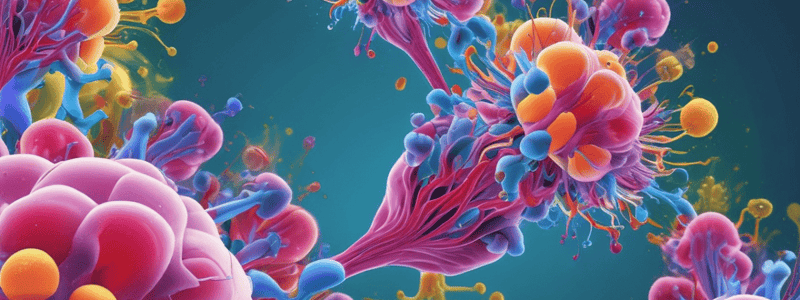Podcast
Questions and Answers
What happens to reaction velocity as temperature increases?
What happens to reaction velocity as temperature increases?
- Decreases continuously
- Increases until a peak is reached, then decreases due to denaturation of proteins (correct)
- Increases indefinitely
- Remains constant
What is the effect of substrate concentration on enzyme reaction velocity?
What is the effect of substrate concentration on enzyme reaction velocity?
- Increases until a maximal velocity (Vmax) is reached (correct)
- Has no impact on reaction velocity
- Remains constant regardless of concentration
- Decreases until no reaction occurs
What defines an irreversible inhibitor of enzyme activity?
What defines an irreversible inhibitor of enzyme activity?
- Is easily reversible by altering enzyme concentration
- Only temporarily inhibits enzyme activity
- Does not affect enzyme activity in any way
- Forms covalent bonds and permanently inactivates enzymes (correct)
How does noncompetitive inhibition affect enzyme activity?
How does noncompetitive inhibition affect enzyme activity?
What characteristic is reflected by the Michaelis-Menten constant (Km)?
What characteristic is reflected by the Michaelis-Menten constant (Km)?
In Michaelis-Menten kinetics, what does Km represent?
In Michaelis-Menten kinetics, what does Km represent?
How does a low Km value affect an enzyme-substrate reaction?
How does a low Km value affect an enzyme-substrate reaction?
What happens to the reaction velocity when [S] < Km in Michaelis-Menten kinetics?
What happens to the reaction velocity when [S] < Km in Michaelis-Menten kinetics?
Which type of inhibition results in a change in Vmax but no change in Km?
Which type of inhibition results in a change in Vmax but no change in Km?
How does pH affect enzyme activity?
How does pH affect enzyme activity?
What does the Michaelis-Menten equation describe?
What does the Michaelis-Menten equation describe?
What is the main assumption/condition for Michaelis-Menten kinetics?
What is the main assumption/condition for Michaelis-Menten kinetics?
In terms of enzyme kinetics, what does Vmax represent?
In terms of enzyme kinetics, what does Vmax represent?
Which type of inhibition involves a substance binding to an enzyme at the active site, preventing the substrate from binding?
Which type of inhibition involves a substance binding to an enzyme at the active site, preventing the substrate from binding?
How does pH affect enzyme activity?
How does pH affect enzyme activity?
What characterizes noncompetitive inhibition?
What characterizes noncompetitive inhibition?
What happens to the velocity of a reaction when zero order of substrate concentration is greater than Km?
What happens to the velocity of a reaction when zero order of substrate concentration is greater than Km?
Why does increasing the substrate concentration not reverse the decrease in Vmax caused by a noncompetitive inhibitor?
Why does increasing the substrate concentration not reverse the decrease in Vmax caused by a noncompetitive inhibitor?
Which type of enzyme kinetics show a hyperbolic curve according to Michaelis-Menten?
Which type of enzyme kinetics show a hyperbolic curve according to Michaelis-Menten?
In competitive inhibition, how do the inhibitors affect enzyme activity?
In competitive inhibition, how do the inhibitors affect enzyme activity?
What type of curve do allosteric enzymes exhibit in terms of their kinetics?
What type of curve do allosteric enzymes exhibit in terms of their kinetics?
How do statin drugs act as competitive inhibitors in cholesterol biosynthesis?
How do statin drugs act as competitive inhibitors in cholesterol biosynthesis?
How do you determine Vmax in a Lineweaver-Burk plot?
How do you determine Vmax in a Lineweaver-Burk plot?
How do β-lactam antibiotics like penicillin act as enzyme inhibitors?
How do β-lactam antibiotics like penicillin act as enzyme inhibitors?
What is the purpose of plotting reciprocal 1/v0 and 1/[S] to obtain a straight line in enzyme kinetics?
What is the purpose of plotting reciprocal 1/v0 and 1/[S] to obtain a straight line in enzyme kinetics?
What effect does aspirin have on prostaglandin and thromboxane synthesis?
What effect does aspirin have on prostaglandin and thromboxane synthesis?
In competitive inhibition, how does the presence of an inhibitor affect the Km value?
In competitive inhibition, how does the presence of an inhibitor affect the Km value?
What is the main difference between competitive and noncompetitive inhibitors?
What is the main difference between competitive and noncompetitive inhibitors?
In competitive inhibition, how does the presence of an inhibitor affect the Lineweaver-Burk plot?
In competitive inhibition, how does the presence of an inhibitor affect the Lineweaver-Burk plot?
How does a noncompetitive inhibitor affect enzyme activity?
How does a noncompetitive inhibitor affect enzyme activity?
Which statement is true about competitive inhibition?
Which statement is true about competitive inhibition?
What effect does a competitive inhibitor have on Km for a given substrate?
What effect does a competitive inhibitor have on Km for a given substrate?
How is enzyme activity affected by noncompetitive inhibition?
How is enzyme activity affected by noncompetitive inhibition?
What is the primary effect of a noncompetitive inhibitor on enzyme function?
What is the primary effect of a noncompetitive inhibitor on enzyme function?
Which of the following statements accurately describes competitive inhibition?
Which of the following statements accurately describes competitive inhibition?
What distinguishes noncompetitive inhibition from competitive inhibition?
What distinguishes noncompetitive inhibition from competitive inhibition?
Flashcards
Enzyme Kinetics & Temperature
Enzyme Kinetics & Temperature
Reaction velocity generally increases with temperature but decreases at extreme temperatures due to denaturation.
Substrate & Velocity
Substrate & Velocity
Higher substrate concentration boosts enzyme reaction velocity until the enzyme is saturated.
Irreversible Inhibitors
Irreversible Inhibitors
An irreversible inhibitor permanently deactivates an enzyme by covalently bonding to it.
Noncompetitive Inhibition
Noncompetitive Inhibition
Signup and view all the flashcards
Michaelis-Menten Constant (Km)
Michaelis-Menten Constant (Km)
Signup and view all the flashcards
Low Km Value
Low Km Value
Signup and view all the flashcards
Reaction Velocity when [S] < Km
Reaction Velocity when [S] < Km
Signup and view all the flashcards
Vmax & Noncompetitive Inhibition
Vmax & Noncompetitive Inhibition
Signup and view all the flashcards
pH Effects on Enzyme Activity
pH Effects on Enzyme Activity
Signup and view all the flashcards
Michaelis-Menten Equation
Michaelis-Menten Equation
Signup and view all the flashcards
Michaelis-Menten Assumption
Michaelis-Menten Assumption
Signup and view all the flashcards
Vmax Definition
Vmax Definition
Signup and view all the flashcards
Competitive Inhibition
Competitive Inhibition
Signup and view all the flashcards
Zero Order Kinetics
Zero Order Kinetics
Signup and view all the flashcards
Vmax & Noncompetitive Inhibition
Vmax & Noncompetitive Inhibition
Signup and view all the flashcards
Hyperbolic Curve
Hyperbolic Curve
Signup and view all the flashcards
Allosteric Enzyme Kinetics
Allosteric Enzyme Kinetics
Signup and view all the flashcards
Statin Drugs
Statin Drugs
Signup and view all the flashcards
Lineweaver-Burk Plot for Vmax
Lineweaver-Burk Plot for Vmax
Signup and view all the flashcards
β-lactam Antibiotics
β-lactam Antibiotics
Signup and view all the flashcards
Purpose of Reciprocal Plotting
Purpose of Reciprocal Plotting
Signup and view all the flashcards
Aspirin's Effect
Aspirin's Effect
Signup and view all the flashcards
Competitive Inhibition and Km
Competitive Inhibition and Km
Signup and view all the flashcards
Competitive vs. Noncompetitive Inhibitors
Competitive vs. Noncompetitive Inhibitors
Signup and view all the flashcards
L-B Plot & Competitive Inhibition
L-B Plot & Competitive Inhibition
Signup and view all the flashcards
Noncompetitive Inhibitor Effects
Noncompetitive Inhibitor Effects
Signup and view all the flashcards
Effects of Noncompetitive Inhibitors
Effects of Noncompetitive Inhibitors
Signup and view all the flashcards
Characteristics of Competitive Inhibition
Characteristics of Competitive Inhibition
Signup and view all the flashcards
Distinguishing Features of Noncompetitive Inhibition
Distinguishing Features of Noncompetitive Inhibition
Signup and view all the flashcards
How non-competitve binders affect efficiency?
How non-competitve binders affect efficiency?
Signup and view all the flashcards
Study Notes
Enzyme Kinetics and Temperature
- Reaction velocity generally increases with temperature due to enhanced molecular collisions but can decrease at extreme temperatures due to denaturation.
Substrate Concentration and Reaction Velocity
- Higher substrate concentration increases enzyme reaction velocity until a saturation point is reached, beyond which the velocity remains constant.
Irreversible Inhibitors
- An irreversible inhibitor covalently binds to an enzyme, permanently deactivating its activity.
Noncompetitive Inhibition
- Noncompetitive inhibition reduces enzyme activity regardless of substrate concentration by binding to an allosteric site, affecting Vmax without changing Km.
Michaelis-Menten Constant (Km)
- Km reflects the substrate concentration at which an enzyme operates at half its maximum velocity (Vmax), indicative of enzyme affinity for the substrate.
Low Km Value Impact
- A low Km indicates a high affinity between enzyme and substrate, leading to effective enzyme-substrate reactions at lower substrate concentrations.
Reaction Velocity at Substrate Concentration < Km
- When substrate concentration is below Km, reaction velocity is directly proportional to substrate concentration, exhibiting first-order kinetics.
Vmax Change and Inhibition
- Noncompetitive inhibition results in a decrease of Vmax, but Km remains unchanged.
pH Effects on Enzyme Activity
- Enzyme activity is highly dependent on pH, with optimal ranges for activity specific to each enzyme; extreme pH levels can lead to denaturation.
Michaelis-Menten Equation
- The Michaelis-Menten equation mathematically describes the rate of enzymatic reactions as a function of substrate concentration.
Main Assumption of Michaelis-Menten Kinetics
- Assumes that the formation of the enzyme-substrate complex is at a steady state and that the breakdown of this complex is the rate-limiting step.
Vmax Definition
- Vmax represents the maximum rate of enzymatic reaction when the enzyme is fully saturated with substrate.
Competitive Inhibition Mechanism
- Competitive inhibitors bind to the active site of the enzyme, blocking substrate access and increasing the apparent Km.
Zero Order Kinetics and Substrate Concentration
- In zero-order kinetics, when substrate concentration exceeds Km, the reaction velocity becomes constant and is independent of substrate concentration.
Vmax and Noncompetitive Inhibition
- Increasing substrate concentration does not reverse the Vmax reduction caused by noncompetitive inhibitors because the inhibitor affects enzyme functionality regardless of substrate levels.
Hyperbolic Curve in Michaelis-Menten Kinetics
- Enzymes following Michaelis-Menten kinetics display a hyperbolic curve when plotting reaction velocity versus substrate concentration.
Allosteric Enzyme Kinetics
- Allosteric enzymes exhibit sigmoidal curves, indicating cooperative binding, as opposed to hyperbolic curves of typical Michaelis-Menten kinetics.
Statin Drugs as Competitive Inhibitors
- Statin drugs competitively inhibit HMG-CoA reductase, reducing cholesterol synthesis by mimicking the natural substrate.
Lineweaver-Burk Plot for Vmax
- Vmax can be determined from the y-intercept of a Lineweaver-Burk plot, which is a double reciprocal graph of reaction velocity versus substrate concentration.
β-lactam Antibiotics Action
- β-lactam antibiotics, like penicillin, inhibit bacterial cell wall synthesis by targeting and inactivating transpeptidase enzymes.
Purpose of Reciprocal Plotting
- Plotting 1/v0 versus 1/[S] facilitates linearization of enzyme kinetics data, simplifying the calculation of Vmax and Km.
Aspirin's Effect on Synthesis
- Aspirin inhibits the cyclooxygenase enzyme, reducing the synthesis of prostaglandins and thromboxanes involved in inflammation and pain.
Competitive Inhibition and Km
- The presence of a competitive inhibitor increases the apparent Km for a given substrate, indicating decreased affinity.
Competitive vs. Noncompetitive Inhibitors
- Competitive inhibitors bind to the active site while noncompetitive inhibitors bind to an allosteric site, affecting enzyme activity differently.
Lineweaver-Burk Plot and Competitive Inhibition
- In competitive inhibition, the presence of an inhibitor increases the slope of the Lineweaver-Burk plot but keeps the y-intercept (1/Vmax) constant.
Noncompetitive Inhibitor Effects
- Noncompetitive inhibitors reduce enzyme activity irrespective of substrate concentration, lowering Vmax without affecting Km.
Primary Effects of Noncompetitive Inhibitors
- They lower the maximum reaction velocity (Vmax) without altering the affinity (Km) for the substrate.
Competitive Inhibition Characteristics
- Competitive inhibition can be outcompeted by increasing substrate concentration, allowing enzymes to reach normal activity.
Distinguishing Features of Noncompetitive Inhibition
- Noncompetitive inhibitors bind to sites other than the active site and do not compete with substrates, leading to decreased enzyme efficiency.
Studying That Suits You
Use AI to generate personalized quizzes and flashcards to suit your learning preferences.
Related Documents
Description
Explore how enzymes function in living cells through in vitro studies. Learn about the impact of substrate concentration on enzyme-catalyzed reactions, including the concept of Vmax and saturation. Discover the influence of temperature and pH on enzyme activity.




